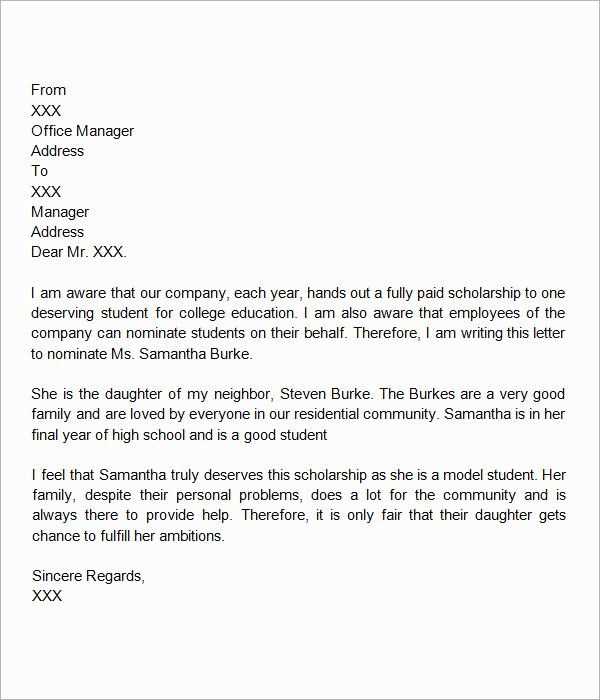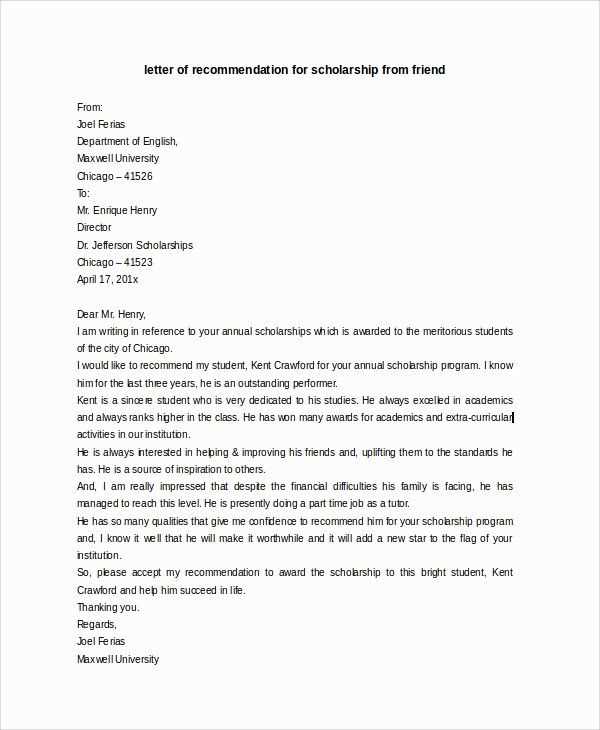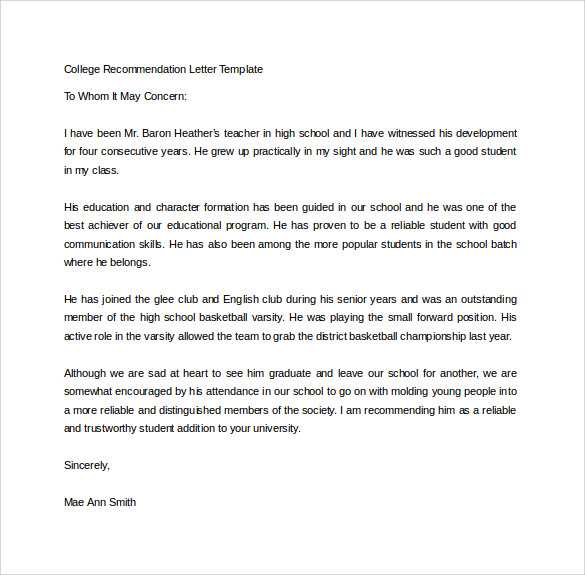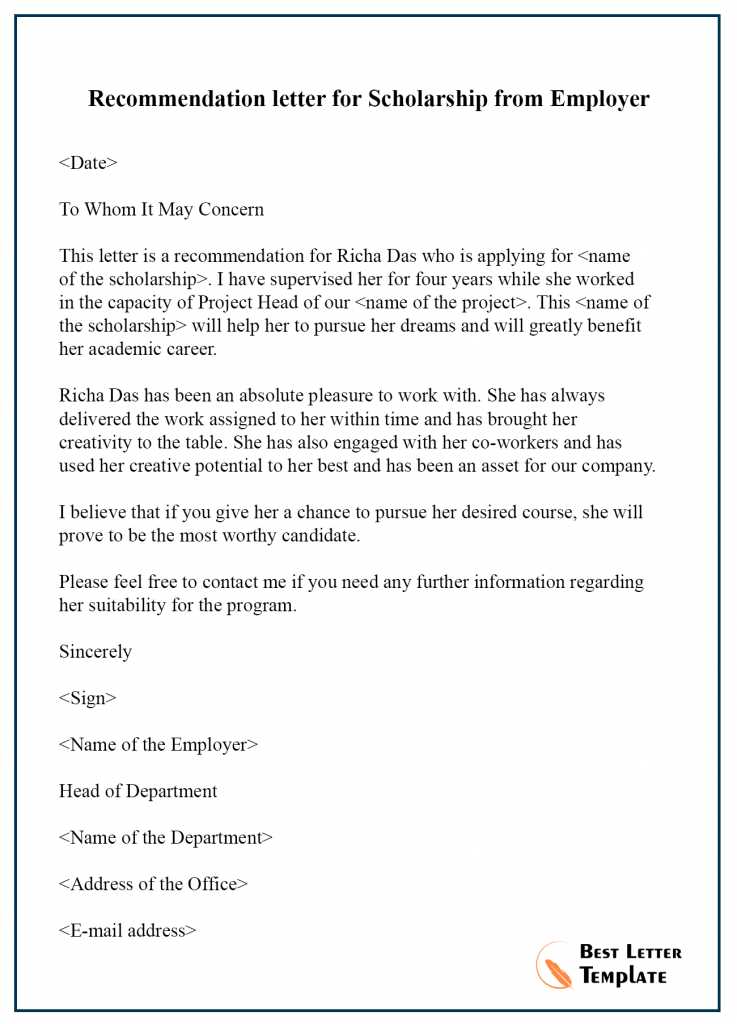Letter of Recommendation for Scholarship Template in Word

When applying for higher education opportunities, a strong endorsement from a mentor or professional can make all the difference. A well-written document that highlights an individual’s qualifications, character, and potential can greatly influence decision-makers. This type of supportive message provides valuable insight into a candidate’s strengths, abilities, and readiness to succeed in their chosen field.
Creating a compelling document requires careful attention to detail. It must be both professional and personal, offering specific examples that demonstrate the candidate’s achievements and unique qualities. By following a structured approach, it’s possible to draft a powerful piece that effectively conveys the necessary information, while also reflecting the writer’s genuine support.
Emphasizing the right points is crucial in delivering a convincing endorsement. It should focus on the attributes most relevant to the desired program or opportunity, ensuring that the message aligns with the expectations of the institution or organization reviewing the application.
How to Write a Scholarship Recommendation
When writing a supportive endorsement for a candidate seeking financial aid or academic opportunities, it’s essential to focus on their qualities, accomplishments, and potential. This type of support document plays a key role in highlighting an individual’s strengths and suitability for a program, making it a valuable asset in the selection process.
To create an impactful endorsement, begin by introducing the candidate and explaining your relationship with them. Be specific about the context in which you have interacted and the length of time you’ve known them. This establishes your credibility as a referee and provides context for your insights.
Highlight key attributes that make the individual stand out. Discuss their academic abilities, work ethic, leadership skills, and any personal characteristics that set them apart. Use concrete examples to illustrate these points, demonstrating how the candidate has excelled in specific situations.
It’s important to align your message with the expectations of the institution or organization reviewing the application. Focus on the qualities that are most relevant to the opportunity and emphasize how the candidate will thrive in their chosen path. A personalized and thoughtful approach is essential to making a strong impression.
Understanding the Importance of Recommendation Letters

A well-crafted support document can have a significant impact on a candidate’s chances of being selected for a desired program or financial aid. It offers a unique perspective on an individual’s qualities, strengths, and potential that might not be fully captured through other parts of the application. Such endorsements provide decision-makers with a deeper understanding of the applicant’s character and abilities.
These written endorsements serve as a bridge between the applicant and the reviewing body, conveying essential insights into how the candidate stands out among peers. Whether it’s showcasing their leadership, work ethic, or academic achievements, these documents provide a more personal touch, offering specific examples that highlight the individual’s suitability for the opportunity.
Personalized endorsements are particularly valuable because they help create a lasting impression. When written effectively, they provide context that numbers and grades simply cannot, influencing the reviewers’ perception and ultimately guiding their decisions. In many cases, these messages can tip the balance between two equally qualified candidates, making them an essential component of the application process.
Best Practices for Crafting a Strong Letter
Creating an impactful document of support involves more than simply listing accomplishments. The key to a compelling endorsement is to focus on clarity, specificity, and authenticity. By following best practices, you can ensure that the message is not only well-received but also memorable.
Start by addressing the candidate’s key strengths and how they align with the goals of the program or opportunity. Specific examples of achievements are crucial, as they help to demonstrate the applicant’s unique qualities. Avoid generic statements and instead focus on personal insights that offer a deeper understanding of the candidate’s capabilities.
| Best Practice | Explanation |
|---|---|
| Provide Specific Examples | Highlight instances where the candidate demonstrated leadership, problem-solving, or other relevant skills. |
| Be Honest and Genuine | Ensure the tone is authentic to avoid sounding overly formal or insincere. |
| Align with Program Goals | Focus on the qualities most valued by the institution or organization, tailoring the endorsement accordingly. |
| Keep It Concise | Avoid long, unnecessary details; instead, focus on powerful, well-supported points. |
By adhering to these guidelines, you ensure that your support document will stand out and make a positive impression on reviewers. A well-crafted message not only enhances the candidate’s chances but also strengthens the trust in your endorsement.
Essential Elements of a Recommendation Letter
To craft an effective support document, there are several key components that must be included to ensure it serves its purpose. These elements help to create a clear, concise, and compelling message that accurately portrays the candidate’s strengths and qualifications. Each section should work together to provide a holistic view of the individual, making the endorsement both meaningful and impactful.
The first essential element is the introduction, where you explain who you are, your relationship with the candidate, and how long you have known them. This establishes your credibility and provides context for the reader. Following that, the main body of the document should highlight specific qualities or achievements, supported by concrete examples that illustrate the individual’s capabilities. Be sure to address areas that are most relevant to the opportunity they are applying for.
Personalized insights are critical. Rather than relying on generic praise, focus on the candidate’s unique strengths and how these traits will help them succeed. Finally, the conclusion should offer a strong endorsement, summarizing why the individual is an excellent choice for the position or program and encouraging the reader to consider them favorably.
Customizing a Template for Your Needs
While starting with a pre-made structure can save time, it’s important to personalize it to best reflect the candidate’s unique qualities and achievements. Customizing a basic format allows you to highlight the specific traits that make the individual stand out. By tailoring the content, you ensure that the message is relevant and impactful.
Identify Key Areas to Personalize

Focus on the sections that will have the most influence on the selection process. Consider the following elements to adjust based on the candidate’s strengths and the goals of the program:
- Introduction: Explain your relationship with the individual and the context of your interactions.
- Core Attributes: Highlight the candidate’s specific skills, accomplishments, or leadership experiences.
- Examples: Replace general statements with concrete examples that demonstrate the candidate’s impact and potential.
Align the Content with the Opportunity

It’s crucial to tailor the document so that it matches the expectations of the institution or organization reviewing the application. Focus on the attributes they value most, and emphasize how the individual’s strengths align with the goals of the opportunity.
- Research the program’s requirements to understand the qualities they prioritize.
- Adjust the tone and details to reflect the needs of the organization.
- Ensure the final document speaks directly to the candidate’s suitability for the role or program.
By personalizing the content in these ways, you ensure that the final endorsement is both specific and powerful, increasing the likelihood of a positive outcome.
Tips for Personalizing Scholarship References
Personalizing an endorsement is essential to ensure it accurately represents the candidate and their unique qualifications. Generic references can fail to capture the candidate’s true potential, so it’s important to add details that make the document stand out. Customizing your message not only makes it more compelling but also helps the reader understand why the individual is an excellent fit for the opportunity.
Start by focusing on the individual’s key strengths and how they specifically align with the goals of the program or organization. Avoid broad statements and instead provide concrete examples that demonstrate the candidate’s abilities. Tailor your language to match the type of program they’re applying for, ensuring that your message resonates with what the reviewers are looking for.
Additionally, be sure to emphasize any personal qualities that set the candidate apart from others. Highlight their work ethic, character, leadership skills, and dedication. This gives the reader a well-rounded view of who they are beyond academic or professional accomplishments.